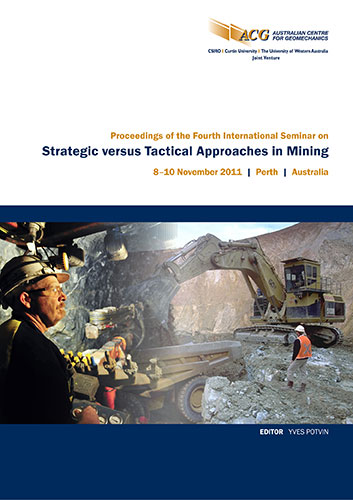Strategic planning versus tactical response effort for mine closure

|
Authors: Knight, K; Hassell, TM Paper is not available for download Contact Us |
DOI https://doi.org/10.36487/ACG_rep/1108_17_Knight
Cite As:
Knight, K & Hassell, TM 2011, 'Strategic planning versus tactical response effort for mine closure', in Y Potvin (ed.), Strategic versus Tactical 2011: Proceedings of the Fourth International Seminar on Strategic versus Tactical Approaches in Mining, Australian Centre for Geomechanics, Perth, pp. 211-222, https://doi.org/10.36487/ACG_rep/1108_17_Knight
Abstract:
Traditionally, mine closure planning within mining companies in Western Australia has focused on, developing corporate frameworks and conceptual strategies for rehabilitating and closing mine sites; or reactionary activities to prevent long-term environmental impacts as the project nears closure stage. These two extremes of mine closure planning represent both the strategic and tactical responses to closing a site. In practice, both often operate independently. An integrated approach to mine closure planning involving both strategic level planning and tactical approaches to implement actions, can result in a comprehensive and workable approach to mine closure. The new Guidelines for Preparing Mine Closure Plans, issued recently by the Environmental Protection Authority and the Department of Mines and Petroleum in Western Australia (DMP, 2011), aim to direct the mining industry to strategically manage mine closure relative to the specific site. This will guide future mine closure planning around a ‘final land use’ appropriate to the site conditions, and management of investigative activities developed over the mining life cycle, utilising a consistent approach that can be monitored and reported against. One of the main components of a strategic approach is the identification of the most appropriate personnel to take part in closure planning. Historically, personnel from the corporation’s environmental department were the key internal stakeholders managing the mine closure plan and planning process. However, to ensure the best closure outcomes as described in the draft guidelines, other personnel such as mining engineers, accountants and appropriate technical consultants should be included in strategic planning, as all of these personnel have a role to play in implementing the closure strategy through the mine life cycle. They can also assist in enabling the desired ‘final land use’ to be identified and refined throughout the project. With respect to environmental management in mine closure, tactical response actions are essential to managing environmental impacts; however, continuously reacting to events impacting on closure outcomes can cause the proponent to lose sight of the ‘final land use’ or the bigger picture of how to close the site. The tactical approach to mine closure is important when reacting to technical issues that suddenly arise and in implementing closure actions in response to changes in the mine plan. URS Australia Pty Ltd draws on case studies in which mine closure for clients and the closure planning process has been successful, incorporating examples of how a tactical approach should be executed over the short-term of a mining life cycle and should be appropriate to the issue to which it is responding, while simultaneously considering the overarching strategies and most importantly, ‘final land use’. This integrated approach can assist the proponent to achieve the desired mine closure outcomes more effectively.
References:
ANZMEC/MCA (2000) Australian and New Zealand Minerals and Energy Council and Minerals Council of Australia. Strategic Framework for Mine Closure, National Library of Australia Catalogue Data.
DITR (2006) Department of Industry, Tourism and Resources. Mine Closure and Completion, Leading Practice Sustainable Development Program for the Mining Industry, Australian Government.
DMP (2009) Department of Mines and Petroleum. Environmental Notes on Mining, Government of Western Australia, Updated Sept 2009, viewed 31 May 2011, .
DMP (2011) Department of Mines and Petroleum. Guidelines for Preparing Mine Closure Plans, Government of Western Australia, Updated June 2011, .
McPhail, G. and Wilkinson, D. (2004) Waste Rock Dump Decommissioning at Mines in Northern Western Australia, Metago Environmental Engineers (Australia) Pty Ltd.
MINEDEX (version 0.9.8) (2011) Mines and Mineral Deposits Database (MINEDEX) Department of Mines and Petroleum, Government of Western Australia, viewed 31 May 2011, appMain.jsp.
© Copyright 2025, Australian Centre for Geomechanics (ACG), The University of Western Australia. All rights reserved.
View copyright/legal information
Please direct any queries or error reports to repository-acg@uwa.edu.au
View copyright/legal information
Please direct any queries or error reports to repository-acg@uwa.edu.au